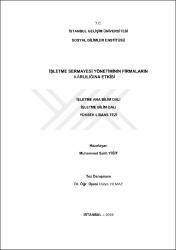| dc.contributor.author | Yiğit, Muhammet Salih | |
| dc.date.accessioned | 2020-07-02T21:27:24Z | |
| dc.date.available | 2020-07-02T21:27:24Z | |
| dc.date.issued | 2019 | en_US |
| dc.date.submitted | 2019-07-25 | |
| dc.identifier.uri | https://hdl.handle.net/11363/2287 | |
| dc.description | Danışman: DR. ÖĞR. ÜYESİ HÜLYA YILMAZ
Yer Bilgisi: İstanbul Gelişim Üniversitesi / Sosyal Bilimler Enstitüsü / İşletme Anabilim Dalı / İşletme Bilim Dalı
Konu: İşletme = Business Administration | en_US |
| dc.description.abstract | Bu çalışmadaki amaç, firmaların işletme sermayesi finansman ve yatırım düzeyleri ile hisse senedi getirisi, risk ve kârlılık arasındaki ilişkiyi belirlemektir. Şirketler için kârlılık ve piyasadaki değerlerini artırmaları en önemli hedeflerden biridir. Firma sermayesi ile firma kârlılığı arasındaki yakın ilişki nedeniyle, işletme sermayesi yönetiminin başarısında risk, kârlılık ve getiri arasında dengeyi sağlamak önemli bir faktördür. Bu dengenin kurulması işletme sermayesi yatırımına ve firmaların finansman seviyesine bağlıdır. Büyük firmalar bünyelerinde bulunan departmanlar sayesinde doğru işletme sermayesi yönetimi uygulayarak günümüz rekabet ortamında daha ileri seviyelerde olmayı hedeflerken, işletme sermayesi yönetimi konusunda bilgi sahibi olmayan küçük ve bazı orta büyüklükteki işletmelerin finansal güçlükler yaşadığı gözlemlenmektedir. Bu hususta bütün işletmeler işletme sermayesi yönetimini benimseyerek doğru ve sistemli bir yönetim sayesinde içinde bulundukları durumları etkin ve verimli bir şekilde yönetmelerini sağlayacaktır. Bu etkenler göz önünde bulundurularak çalışmamızda işletme sermayesinin önemi, çeşitleri, değişen dönemsel şartlara göre işletme sermayesi ihtiyacını etkileyen işletme içi ve dışı faktörlerin neler olduğu açıklanmak istenmektedir. Ayrıca firmaların yeterli işletme sermayesine sahip olup olmadıklarını günün, sektörün ve işletmenin içinde bulunduğu koşullara göre hangi durumlar ile karşılaşabilecekleri anlatılarak, işletme sermayesinin yeterliliğini hesaplama yöntemleri açıklanmaktadır. Bir işletmenin yapısal olarak hangi unsurlardan oluştuğu ve işletmenin kuruluş amacı olan kâr elde edebilme ve büyüyebilmesi için işletmenin konjonktürel durumu dikkate alınarak kendisi için uygun olan finanslama stratejileri açıklanmaktadır. Analiz kısmında BIST'de kayıtlı 36 firmanın, 2000 ile 2018 yılları arasında, Faaliyet Karı/Toplam Aktifler (PRF), Toplam Borç/Toplam Aktifler (TBTA) ve Nakit Dönüş Süresi (NDS) arasındaki ilişkiler incelenmiştir. Seriler arasındaki kısa dönem nedensellik ilişkisi incelenmiş, Faaliyet Kârı/Toplam aktifler (KAR) ile Toplam Borç (TB) arasında çift-yönlü, KAR ile NDS arasında çift yönlü, TB ile NDS arasında çift yönlü ilişki olduğu tespit edilmiştir. Uzun dönem ilişkilerin incelenmesi heterojenliği ve birimler arası korelasyonu dikkate alan ikinci kuşak hata düzeltme modellerinde TB ile KAR arasındaki ilişki pozitif, NDS ile KAR arasındaki ilişki negatif olarak bulunmuştur. Kısa döneme ilişkin sonuçlarda da, TB ile KAR arasındaki ilişki pozitif ve NDS ile KAR arasındaki ilişki negatif olarak tespit edilmiştir. | en_US |
| dc.description.abstract | The aim of this study is to determine the relationship between working capital financing and investment levels of firms and return on equity, risk and profitability. One of the most important targets for companies is to increase their profitability and increase their market value. Because of the close relationship between firm capital and firm profitability, balancing risk, profitability and return is an important factor in the success of working capital management. Establishing this balance depends on the investment of working capital and the level of financing of firms. While large firms aim to be more advanced in today's competitive environment by applying the correct working capital management thanks to the departments within their bodies, it is observed that small and medium-sized enterprises without knowledge of working capital management experience financial difficulties. In this respect, all enterprises will adopt working capital management and ensure that they manage their situations effectively and efficiently thanks to correct and systematic management. Considering these factors, in our study, it is aimed to explain the importance and types of working capital and the factors that affect the working capital needs according to the changing period conditions. In addition, if the firms have sufficient working capital, the conditions they can face according to the conditions of the day, sector and business are explained and the methods of calculating the adequacy of working capital are explained. The structural elements of an enterprise and the financial strategies that are suitable for the enterprise are explained by considering the business's cyclical situation in order to make profit and grow. In the analysis section, the relationships between the Operating Profit / Total Assets (PRF), Total Debt / Total Assets (TBTA) and Cash Return Period (NDS) of 36 companies registered in BIST between 2000 and 2018 are analyzed. The short-term causality relationship between the series was examined and it was found that there was a two-way relationship between Operating Profit / Total assets (PROF) and Total Debt (TB), a two-way relationship between KAR and NDS, and a two-way relationship between TB and NDS. In the second generation error correction models considering the heterogeneity and inter-unit correlation, the relationship between TB and KAR was positive and the relationship between NDS and KAR was negative. In the short-term results, the relationship between TB and KAR was positive and the relationship between NDS and KAR was negative. | en_US |
| dc.language.iso | tur | en_US |
| dc.publisher | İstanbul Gelişim Üniversitesi Sosyal Bilimler Enstitüsü | en_US |
| dc.rights | info:eu-repo/semantics/openAccess | en_US |
| dc.rights | Attribution-NonCommercial-NoDerivs 3.0 United States | * |
| dc.rights.uri | http://creativecommons.org/licenses/by-nc-nd/3.0/us/ | * |
| dc.subject | İşletme Sermayesi | en_US |
| dc.subject | Risk | en_US |
| dc.subject | Karlılık | en_US |
| dc.subject | Finanslama Stratejileri | en_US |
| dc.subject | Working Capital | en_US |
| dc.subject | Profitability | en_US |
| dc.subject | Financing Strategies | en_US |
| dc.title | İşletme sermayesi yönetiminin firmaların kârlılığına etkisi | en_US |
| dc.title.alternative | The effect of working capital management on profitability of firms | en_US |
| dc.type | masterThesis | en_US |
| dc.department | Sosyal Bilimler Enstitüsü | en_US |
| dc.relation.publicationcategory | Tez | en_US |



















